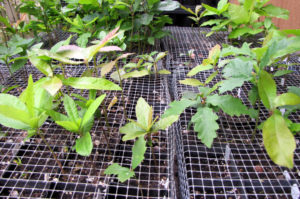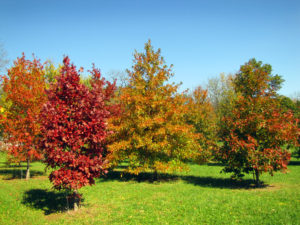 We began growing oaks in 1968, seeking to try to have first-generation (F1) hybrids by growing seeds from a tree located adjacent to genetically compatible trees of another species. One of those progeny grew into an outstanding ornamental tree and eventually became our first cultivar selection. As we planted more oaks, and other trees, variabilities of weather extremes along with a limited water supply taught us that it was prudent to grow trees such as oaks that could survive our conditions with minimal care once established. Starhill Forest expanded further to add some tropical and subtropical oaks that would be kept in containers and wintered in a greenhouse built especially for them. The arboretum grew over the next four decades into what eventually became the most comprehensive APGA-certified oak collection in North America, with more than 700 individual trees representing several hundred species, varieties, and cultivars. The genetic and provenance study of the oak genus became focused upon one of the most widespread and variable of all oaks, the bur oak (Quercus macrocarpa). We gathered them from more than 100 locations throughout the tree’s natural range in the US and Canada. Because all of our trees are fully documented, and so many have come from spontaneous wild populations, Starhill Forest has become the key oak location in North America for genetic sampling as well as morphometric and phenological study.
We began growing oaks in 1968, seeking to try to have first-generation (F1) hybrids by growing seeds from a tree located adjacent to genetically compatible trees of another species. One of those progeny grew into an outstanding ornamental tree and eventually became our first cultivar selection. As we planted more oaks, and other trees, variabilities of weather extremes along with a limited water supply taught us that it was prudent to grow trees such as oaks that could survive our conditions with minimal care once established. Starhill Forest expanded further to add some tropical and subtropical oaks that would be kept in containers and wintered in a greenhouse built especially for them. The arboretum grew over the next four decades into what eventually became the most comprehensive APGA-certified oak collection in North America, with more than 700 individual trees representing several hundred species, varieties, and cultivars. The genetic and provenance study of the oak genus became focused upon one of the most widespread and variable of all oaks, the bur oak (Quercus macrocarpa). We gathered them from more than 100 locations throughout the tree’s natural range in the US and Canada. Because all of our trees are fully documented, and so many have come from spontaneous wild populations, Starhill Forest has become the key oak location in North America for genetic sampling as well as morphometric and phenological study.

Though the oaks had been growing in number and size for decades at Starhill, the collection gained formal recognition in 2009 with induction into the multi-institutional Plant Collections Network as a Quercus reference collection. The Plant Collections Network is able to coordinate efforts among botanical institutions to preserve the greatest diversity of species and genetics within a species, while promoting professional standards of collections management and opening doors for research and collaboration between participants.
Requests for plant material, to view trees in the collection, or simply for more information can be made by contacting Alana McKean or Guy Sternberg.

